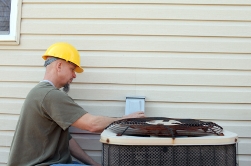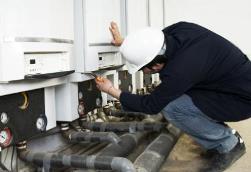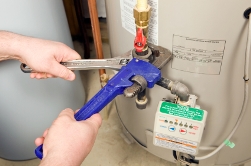How to Select an HVAC School near Stanford Illinois
 Once you have come to a decision on a career as a heating and air conditioner professional, the next action is to locate an HVAC trade school near Stanford IL. But with so many to select from, how do you choose the best one to receive the training that you require? A number of prospective students will make their selection based solely on the cost of tuition or how near the school is to their home. Even though these are relevant factors to consider, they are not the only ones to take into account. Some of the other things that you need to look into are the graduation completion rates of the HVAC schools, their reputations, and if they are accredited by professional trade organizations. These and other benchmarks will be addressed in more detail later within this article. But before we tackle how to choose an HVAC trade school, let’s take a look at what a heating and cooling contractor does to become a licensed qualified tradesman.
Once you have come to a decision on a career as a heating and air conditioner professional, the next action is to locate an HVAC trade school near Stanford IL. But with so many to select from, how do you choose the best one to receive the training that you require? A number of prospective students will make their selection based solely on the cost of tuition or how near the school is to their home. Even though these are relevant factors to consider, they are not the only ones to take into account. Some of the other things that you need to look into are the graduation completion rates of the HVAC schools, their reputations, and if they are accredited by professional trade organizations. These and other benchmarks will be addressed in more detail later within this article. But before we tackle how to choose an HVAC trade school, let’s take a look at what a heating and cooling contractor does to become a licensed qualified tradesman.
[campusexplorer header_text=”Find HVAC Training Schools Near You!” aos=”53237562″ concentration=”16D42C74″ tracking=”HVAC-D”]
Becoming an HVAC Specialist in Stanford IL
 HVAC is an acronym that is frequently used in the business that stands for “Heating, Ventilation and Air Conditioning”. HVAC professionals provide services for the installation, repair and maintenance of air conditioners, furnaces, boilers, water heaters and heating systems. As skilled tradesmen, they are generally required to be licensed, however each state and local municipality has its own prerequisites. Attaining professional certification is not required, but an optional means for Stanford IL HVAC technicians to demonstrate that they are highly qualified and accomplished in their area of expertise. There are several acknowledged certifications within the trade that are offered. Below are a few of the significant ones.
HVAC is an acronym that is frequently used in the business that stands for “Heating, Ventilation and Air Conditioning”. HVAC professionals provide services for the installation, repair and maintenance of air conditioners, furnaces, boilers, water heaters and heating systems. As skilled tradesmen, they are generally required to be licensed, however each state and local municipality has its own prerequisites. Attaining professional certification is not required, but an optional means for Stanford IL HVAC technicians to demonstrate that they are highly qualified and accomplished in their area of expertise. There are several acknowledged certifications within the trade that are offered. Below are a few of the significant ones.
- North American Technician Excellence (NATE). NATE is a nationally acknowledged certification for HVAC techs. The certification is attained by passing a proficiency examination and can be earned in one or more specialties.
- HVAC Excellence. This certification offers both a professional and a master specialist credential. Two years of professional experience in addition to passing a comprehensive examination are required for the professional level certification. Master specialists need to have 3 years of experience as well as a passing result on the professional level examination. As with NATE, certifications are provided in multiple specialties.
- EPA Section 608. This certification is mandatory for specialists that work with refrigerants. There are three forms of certification obtainable, one for small appliances, and the additional two for low and high pressure refrigerants.
Because licensing could be required in your area, and you may also desire to obtain certification, it’s essential that you pick an HVAC vocational school that will prepare you for both. And since you will probably be dealing with refrigerants, make sure that the school you select preps you for passing the EPA Section 608 exams.
HVAC Certificate and Degree Training Programs
 There are a number of choices offered for HVAC training in a technical or vocational school. You can obtain a certificate, an Associate Degree, or a Bachelor’s Degree. Earning a certificate will take the lesser amount of time, often achieved in just 6 months, although some courses are longer. A certificate will train you for the majority of HVAC positions, particularly if you are licensed and have certification applicable to the position. The degree training programs may provide a competitive advantage for securing employment and will furnish more extensive training than the certificate programs. Below is a short summary of each option offered near Stanford IL.
There are a number of choices offered for HVAC training in a technical or vocational school. You can obtain a certificate, an Associate Degree, or a Bachelor’s Degree. Earning a certificate will take the lesser amount of time, often achieved in just 6 months, although some courses are longer. A certificate will train you for the majority of HVAC positions, particularly if you are licensed and have certification applicable to the position. The degree training programs may provide a competitive advantage for securing employment and will furnish more extensive training than the certificate programs. Below is a short summary of each option offered near Stanford IL.
- Certificate. Usually requiring a high school diploma, certificate programs are very popular among entry level commercial or residential HVAC specialists. They provide a solid foundation of skills for job opportunities within the trade.
- Associate Degree. The Associate Degree in HVAC program provides a more extensive background of heating & cooling systems than the certificate program. Normally requiring two years to complete, some degrees incorporate an internship or work-study program.
- Bachelor’s Degree. The Bachelor’s Degree in HVAC is suited more towards a career in management as well as business ownership. Some programs require an Associate Degree, while others are a conventional four year program. In addition to learning how to service and maintain heating and cooling systems, you will also learn how to design them.
Choosing the right credential program will be dependent on what your long term career objectives are, along with the time and financial resources that you have to invest. One possibility is to start with a certificate or even an Associate Degree program, and after getting some experience in the field in Stanford IL, eventually going back to earn a Bachelor’s Degree. If this is your tactic, make certain to ask the HVAC tech school you are looking at about how their returning student program works.
HVAC Classes Online
 Attending an HVAC school online is one option to obtaining your training and earning a degree or certificate. Nearly all schools will call for some attendance on campus to take part in hands on training. Some also sponsor internship or work-study programs in addition to or instead of practical lab work. But since the remainder of the classes can be participated in online, this option may be a more convenient solution for some Stanford IL students that are pressed for time. And many online degree programs are more economical than other traditional choices. Even travelling expenses from Stanford and study materials may be lessened, helping to make schooling more budget-friendly. And a large number of online schools are fully accredited (more on this later). So if your work or family commitments have left you with little time to attend classes, maybe an HVAC online training program will make it less complicated to accommodate school into your active lifestyle.
Attending an HVAC school online is one option to obtaining your training and earning a degree or certificate. Nearly all schools will call for some attendance on campus to take part in hands on training. Some also sponsor internship or work-study programs in addition to or instead of practical lab work. But since the remainder of the classes can be participated in online, this option may be a more convenient solution for some Stanford IL students that are pressed for time. And many online degree programs are more economical than other traditional choices. Even travelling expenses from Stanford and study materials may be lessened, helping to make schooling more budget-friendly. And a large number of online schools are fully accredited (more on this later). So if your work or family commitments have left you with little time to attend classes, maybe an HVAC online training program will make it less complicated to accommodate school into your active lifestyle.
What to Ask HVAC Trade Schools near Stanford IL
When you have picked the type of certificate or degree that you wish to obtain, either online or on campus, you can start to narrow down your selection of schools. As you are certainly aware, there are a large number of HVAC technical schools in the Stanford IL area and all over the United States to pick from. That’s why it is very important to have a checklist of key qualifications when making school assessments. As formerly stated in our opening paragraph, location and tuition will undoubtedly be the initial two aspects you will consider. Following are some additional ones that you will want to explore before enrolling in your school of choice.
Accreditation. Many HVAC vocational schools in the Stanford IL area have received either a regional or a national accreditation. They can receive Institutional Accreditation, which involves the school’s programs overall, or Programmatic Accreditation, which relates to an individual program, such as HVAC technology. Make sure that the program and school are accredited by a U.S. Department of Education approved accrediting organization, for example the Accreditation Board for Engineering and Technology. In addition to helping ensure that you receive a superior education, it can assist in securing financial assistance or student loans, which are often unavailable for non-accredited schools. Furthermore, some states mandate that the HVAC training program be accredited for it to be approved for licensing.
High Completion Rates. Ask the Heating and Cooling schools you are looking at what their completion rates are. The completion rate is the portion or percentage of students who enroll in and complete the course. A lower completion rate might indicate that students were unhappy with the course and dropped out. It may also indicate that the teachers were not competent to instruct the students. It’s similarly important that the schools have higher job placement rates. Older and/or more reputable schools may have a broader directory of graduates, which can result in more contacts for the school to use for their apprenticeship and job placement programs. A high job placement rate can not only validate that the school has an excellent reputation within the industry, but additionally that it has the network of Stanford IL HVAC employers to assist grads secure apprenticeships or employment.
Apprenticeship Programs. Many HVAC trade programs are taught along with an apprenticeship or an internship program. Those participating vocational and trade programs will help place you in an apprenticeship program within their network of Heating and Cooling businesses or labor unions. Find out if the schools you are reviewing have working partnerships with local Stanford IL HVAC specialists. An apprenticeship not only offers a rewarding experience by furnishing practical training, but it also furnishes job opportunities and helps to build relationships in the local HVAC professional community.
Modern Facilities. Make sure that the school facilities and the tools that you will be trained on are state-of-the-art and what you will be using in the field. If you are already in an internship or an apprenticeship, talk to the HVAC technician you are working with regarding what you should be looking for. Otherwise, ask a local Stanford IL HVAC contracting company if they can provide some suggestions. Also keep in mind that unless you are willing to relocate, the school must be within commuting distance of your Stanford IL residence. Remember that if you decide to enroll in an out-of-state school, in addition to moving costs there may be higher tuition charges compared to in-state residents.
Smaller Classes. It’s important that you get as much one-on-one instruction as possible, which can be difficult in bigger classes. Ask if you can monitor a few of the classes so that you can observe how big they are and witness first hand the interaction between students and teachers. Speak to a few of the students and get their feedback regarding class sizes and instruction. Finally, speak with some of the instructors and learn what their level of experience is and what degrees or certifications they hold.
Flexible Scheduling. Verify that the class schedules for the programs you are reviewing are flexible enough to meet your needs. If you can only attend classes in the evening or on weekends near Stanford IL, confirm that the schools you are comparing provide those options. If you can only attend on a part-time basis, make certain that the school you select offers part-time enrollment. Finally, ask what the policy is to make-up classes should you miss any due to work, illness or family responsibilities.
Attending HVAC School near Stanford IL?
Stanford, Illinois
Stanford was platted, under the name of Allin, on December 14, 1867. Its founder was John Armstrong (January 20, 1820 - August 7, 1912).[4] It was founded when the Jacksonville Division of the Chicago Alton and St. Louis Railroad was extended westward from Bloomington. The McLean County town of Covell was founded, within a few months of Allen, as a station on the same railroad. In 1870 the name of the town was changed to Stanford. It was incorporated as a village in June 1874. The town's founder, John Armstrong was born in Posey County, Indiana. He was first a farmer and then ran a grocery in Stanford, where he continued to live until his death in 1912. For many years after the town was founded John Armstrong ran a grocery in Stanford.[5]
The original town of what would soon become Stanford had an unusual "L" shaped design, with the leg of the "L" extending to the east along the railroad tracks. The large area in the crook of the "L" was not platted, but remained in the hands of John Armstrong, the town founder, whose residence was near the tracks on the north side of the railroad. Rather than a central square, the original plat of Stanford, like many towns laid out in the 1850s and 1860s, featured two rectangular public areas labeled as "Depot Grounds" which extended along either side of the tracks. The depot itself was on the north side of the tracks and, in 1874, the grain elevator on the south side.[6] As the town developed most businesses were located south of the tracks. By 1895 these included a hotel, a bank, the Masonic Hall, and several stores. Except for the depot, most of the railroad related facilities were on the Depot Ground south of the railroad. These included a stock yard, a Lumber yard, and several elevators. This area also held a band stand. There were two early churches in Stanford: the Christian Church on Boundary Street south of the business district and the Presbyterian Church in the southeastern part of town.[7]
As of the census[9] of 2000, there were 670 people, 236 households, and 190 families residing in the village. The population density was 1,749.8 people per square mile (680.8/km²). There were 253 housing units at an average density of 660.8 per square mile (257.1/km²). The racial makeup of the village was 97.91% White, 0.90% Native American, 0.15% Asian, and 1.04% from two or more races. Hispanic or Latino of any race were 0.90% of the population.
Pick the Right HVAC Training Course near Stanford IL
Selecting the right HVAC training program is a critical first step toward a gratifying career in the heating & cooling trade. As we have addressed in this post, you need to pick a school and a degree or certificate program that are both accredited and have exceptional reputations within the HVAC community. Other things to look for are sufficient practical training and state-of-the-art facilities. You need to visit each of the schools personally that you are most interested in to inspect the campus and talk with both the current students and faculty. Try to get a feel for the quality of the teaching and the interaction between them. Additionally, inquire about scheduling options and if night or weekend classes are available if needed. And remember to ask about financial assistance and student loan options as well. If you ask the right questions as we have laid out in our checklist for assessing schools, you’ll be able to narrow down your choices so that you can make an informed decision. With the right training, hard work and commitment, you can eventually become a licensed HVAC specialist in Stanford IL.
More Fabulous Cities in Illinois
Business Results 1 - 10 of 122











